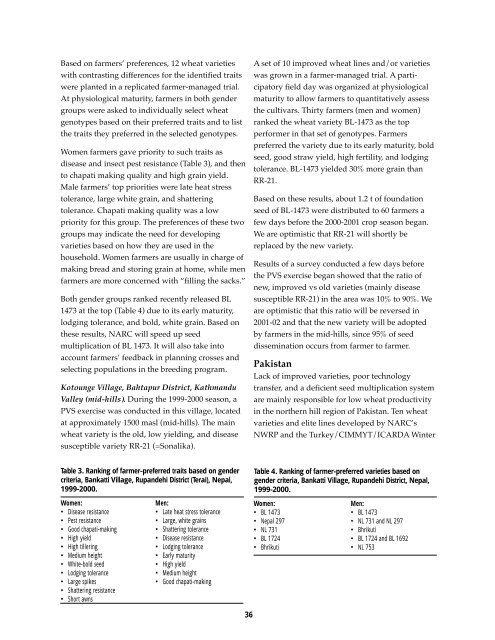Research Highlights of the CIMMYT Wheat Program 1999-2000
Research Highlights of the CIMMYT Wheat Program 1999-2000
Research Highlights of the CIMMYT Wheat Program 1999-2000
You also want an ePaper? Increase the reach of your titles
YUMPU automatically turns print PDFs into web optimized ePapers that Google loves.
Based on farmers’ preferences, 12 wheat varieties<br />
with contrasting differences for <strong>the</strong> identified traits<br />
were planted in a replicated farmer-managed trial.<br />
At physiological maturity, farmers in both gender<br />
groups were asked to individually select wheat<br />
genotypes based on <strong>the</strong>ir preferred traits and to list<br />
<strong>the</strong> traits <strong>the</strong>y preferred in <strong>the</strong> selected genotypes.<br />
Women farmers gave priority to such traits as<br />
disease and insect pest resistance (Table 3), and <strong>the</strong>n<br />
to chapati making quality and high grain yield.<br />
Male farmers’ top priorities were late heat stress<br />
tolerance, large white grain, and shattering<br />
tolerance. Chapati making quality was a low<br />
priority for this group. The preferences <strong>of</strong> <strong>the</strong>se two<br />
groups may indicate <strong>the</strong> need for developing<br />
varieties based on how <strong>the</strong>y are used in <strong>the</strong><br />
household. Women farmers are usually in charge <strong>of</strong><br />
making bread and storing grain at home, while men<br />
farmers are more concerned with “filling <strong>the</strong> sacks.”<br />
Both gender groups ranked recently released BL<br />
1473 at <strong>the</strong> top (Table 4) due to its early maturity,<br />
lodging tolerance, and bold, white grain. Based on<br />
<strong>the</strong>se results, NARC will speed up seed<br />
multiplication <strong>of</strong> BL 1473. It will also take into<br />
account farmers’ feedback in planning crosses and<br />
selecting populations in <strong>the</strong> breeding program.<br />
Kotounge Village, Bahtapur District, Kathmandu<br />
Valley (mid-hills). During <strong>the</strong> <strong>1999</strong>-<strong>2000</strong> season, a<br />
PVS exercise was conducted in this village, located<br />
at approximately 1500 masl (mid-hills). The main<br />
wheat variety is <strong>the</strong> old, low yielding, and disease<br />
susceptible variety RR-21 (=Sonalika).<br />
A set <strong>of</strong> 10 improved wheat lines and/or varieties<br />
was grown in a farmer-managed trial. A participatory<br />
field day was organized at physiological<br />
maturity to allow farmers to quantitatively assess<br />
<strong>the</strong> cultivars. Thirty farmers (men and women)<br />
ranked <strong>the</strong> wheat variety BL-1473 as <strong>the</strong> top<br />
performer in that set <strong>of</strong> genotypes. Farmers<br />
preferred <strong>the</strong> variety due to its early maturity, bold<br />
seed, good straw yield, high fertility, and lodging<br />
tolerance. BL-1473 yielded 30% more grain than<br />
RR-21.<br />
Based on <strong>the</strong>se results, about 1.2 t <strong>of</strong> foundation<br />
seed <strong>of</strong> BL-1473 were distributed to 60 farmers a<br />
few days before <strong>the</strong> <strong>2000</strong>-2001 crop season began.<br />
We are optimistic that RR-21 will shortly be<br />
replaced by <strong>the</strong> new variety.<br />
Results <strong>of</strong> a survey conducted a few days before<br />
<strong>the</strong> PVS exercise began showed that <strong>the</strong> ratio <strong>of</strong><br />
new, improved vs old varieties (mainly disease<br />
susceptible RR-21) in <strong>the</strong> area was 10% to 90%. We<br />
are optimistic that this ratio will be reversed in<br />
2001-02 and that <strong>the</strong> new variety will be adopted<br />
by farmers in <strong>the</strong> mid-hills, since 95% <strong>of</strong> seed<br />
dissemination occurs from farmer to farmer.<br />
Pakistan<br />
Lack <strong>of</strong> improved varieties, poor technology<br />
transfer, and a deficient seed multiplication system<br />
are mainly responsible for low wheat productivity<br />
in <strong>the</strong> nor<strong>the</strong>rn hill region <strong>of</strong> Pakistan. Ten wheat<br />
varieties and elite lines developed by NARC’s<br />
NWRP and <strong>the</strong> Turkey/<strong>CIMMYT</strong>/ICARDA Winter<br />
Table 3. Ranking <strong>of</strong> farmer-preferred traits based on gender<br />
criteria, Bankatti Village, Rupandehi District (Terai), Nepal,<br />
<strong>1999</strong>-<strong>2000</strong>.<br />
Table 4. Ranking <strong>of</strong> farmer-preferred varieties based on<br />
gender criteria, Bankatti Village, Rupandehi District, Nepal,<br />
<strong>1999</strong>-<strong>2000</strong>.<br />
Women:<br />
• Disease resistance<br />
• Pest resistance<br />
• Good chapati-making<br />
• High yield<br />
• High tillering<br />
• Medium height<br />
• White-bold seed<br />
• Lodging tolerance<br />
• Large spikes<br />
• Shattering resistance<br />
• Short awns<br />
Men:<br />
• Late heat stress tolerance<br />
• Large, white grains<br />
• Shattering tolerance<br />
• Disease resistance<br />
• Lodging tolerance<br />
• Early maturity<br />
• High yield<br />
• Medium height<br />
• Good chapati-making<br />
Women:<br />
• BL 1473<br />
• Nepal 297<br />
• NL 731<br />
• BL 1724<br />
• Bhrikuti<br />
Men:<br />
• BL 1473<br />
• NL 731 and NL 297<br />
• Bhrikuti<br />
• BL 1724 and BL 1692<br />
• NL 753<br />
36

















